|
Psocoptera:
booklice
Characteristics
Psocids
or booklice as they are commonly known are small usually dull coloured
insects with a body length of 1-10 millimetres. All psocids possess
silk glands and in some species large webs are formed in which the
community lives. Psocids are sometimes mistaken for aphids (Hemiptera)
but can be distinguished by the following features:
|
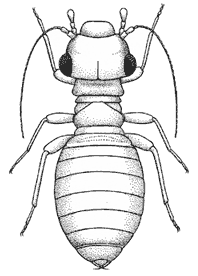
Lepinotus reticulatus (TROGIIDAE)
|
|
- Large head
with protruding eyes
- 2 pairs of
membranous
wings held rook-like over the abdomen when at rest. Wings have
reduced venation and forewings are larger than hind wings. Some
species are wingless
The nymphs
of psocids generally resemble adults but lack wings. Many of the
common indoor species of worldwide origin belong to the TROGIIDAE
family such as Lepinotus reticulatus.
Life Cycle
Most male
psocids perform a mating dance and after fertilisation the female
lays her eggs under bark, leaves or a silk mat. Eggs may be laid
one at a time or in clusters. Nymphs
appear similar to the adults and usually develop through an average
of 6 moults
before they reach maturity, although some species begin to develop
wing buds by the second instar
stage.
|
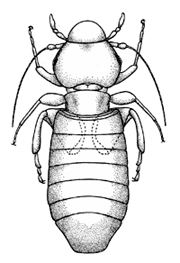
Liposcelis bostrychophilus
(LIPOSCELIDAE)
|
Feeding
Psocids
feed mostly on organic matter such as lichens, algae, plant spores
and dead plant and insect material. A few species have become pests
and feed on stored products and paper materials, which is where
they get the name 'booklice'.
Members of
LIPOSCELIDAE are commonly found under bark. Liposcelis bostrychophilus
are small and flattened with enlarged hind femora.
Liposcelis species can occur in large numbers in houses
and other buildings, merchandise stores and ships where they become
pests by damaging stored food products (see below), paper products
such as books and insects collections.
Many
of these species are found worldwide and the traditional 'booklice'
species belongs to this genus.
Liposcelis
decolor (below left) is a psocopteran species that commonly
occurs in grain storage. This species often becomes a serious pest
as it can build up huge populations contaminating grain. In the
image (below right) the dark brown patches on the top of this mound
of grain are thousands and thousands of Liposcelis decolor.
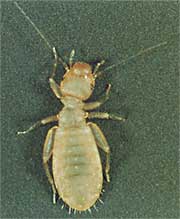
Liposcelis decolor |
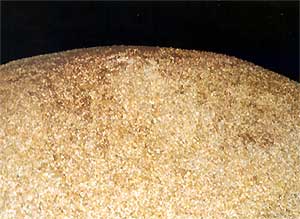
Liposcelis decolor infestation |
Habitat
Psocids
live in a wide variety of habitats throughout most of Australia,
preferring moist environments. The majority can be found on vegetation,
including plant foliage, branches and bark or amongst leaf litter.
A few species are found in association with humans and occur in
amongst books or in food products.
Myopsocus
australis is a large common species, recognisable by its mottled
wings and can be found on paling fences or the bark of trees where
they feed on algae and lichens.
|
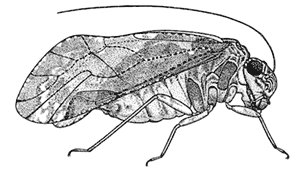
Myopsocus australis
|
|





